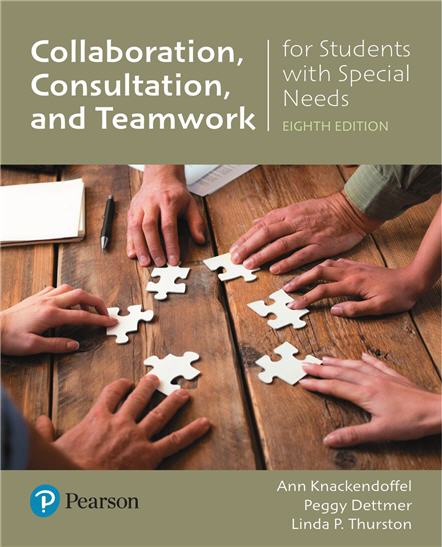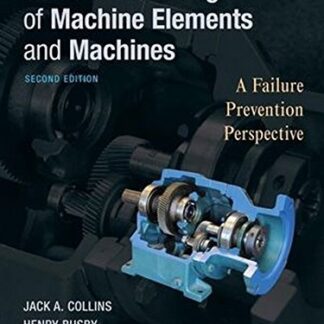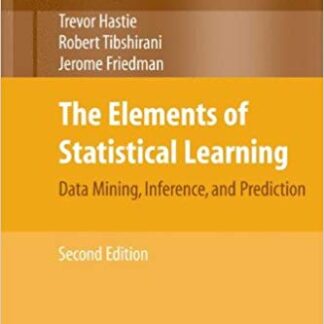Description
Collaborating, Consulting, and Working in Teams for Students with Special Needs 8th Edition, ISBN-13: 978-0134672588
[PDF eBook eTextbook] – Available Instantly
- Publisher : Pearson; 8th edition (March 28, 2017)
- Language : English
- 496 pages
- ISBN-10 : 0134672585
- ISBN-13 : 978-0134672588
NOTE: This eBook is a standalone eBook and will not include any access codes.
For courses in Collaboration, Consultation, or Co-Teaching.
A focus on collaboration in a variety of environments that emphasizes constructive ways to use educator differences to serve students with special needs.
This all-in-one resource gives educators a broad look at the history of collaboration, ways to structure and implement collaborative teams, important processes and practices that ensure effective co-educator partnerships, and the external support that makes collaborative school consultation successful. Collaborating, Consulting and Working in Teams for Students with Special Needs shows what it means to blend the professional perspectives and personal preferences of co-educators using real-life applications, and numerous examples of school-based situations in vignettes and case studies. Filled with new chapter-opening classroom scenarios and updated activities, the Eighth Edition prepares educators, school personnel, families, and community leaders with a strong knowledge base that celebrates the strengths in personal differences.
Table of Contents:
About the Authors
Brief Table of Contents
Contents
Preface
New to This Edition
Instructor Supplements
Chapter 1 Working Together in Collaboration, Consultation, and Teams
Chapter Objectives
Key Terms
Why Work Together as Educators?
Describing Collaboration, Consultation, and Teamwork
Motivation for Working Together
What Collaborative Consultation Is
What Collaborative Consultation Is Not
Role Opportunities and Responsibilities in Collaborative Endeavors
Interchangeable Roles and Responsibilities
Historical Background of Collaborative School Consultation
Collaborative School Consultation in Historical Perspective
Benefits of Collaborative School Consultation
Why It Can Be Difficult to Work Together
Competencies for Effective Collaborative School Consultants
The Collaborative School Consultation Ethic
Tips for Working Together in Schools
Chapter 2 Working Together with Differing Perspectives and Preferences
Chapter Objectives
Key Terms
Differentiating between Professional Perspectives and Personal Preferences
Differences in Professional Perspectives on Tradition, and Much More
The Tradition Factor
The Time Factor
The Territory (Turf) Factor
The Taxonomy Factor
Taxonomy of the Cognitive Domain
Taxonomy of the Affective Domain
Extending the Cognitive and Affective Taxonomies
Taxonomy of the Sensorimotor Domain
Taxonomy of the Social Domain
The Talents Factor
The Trust Factor
Areas of Differences in Teacher Practices
General Education and Special Education
Grade Levels and Curriculum Areas
More Differences Influencing Professional Perspectives
Types of Learning Theory
Three Kinds of Subject Matter
Annual Goals and Instructional Objectives
Time and Achievement Dimensions
Assessment and Evaluation Processes
Differences in Personal Preferences that Affect Collaboration among Co-Educators
Self Study of Your Professional Perspectives and Personal Preferences as an Educator
Respecting Different Viewpoints and Different Inclinations as Collaborators
Using Adult Differences to Facilitate Collaboration
Tips for Using Co-Educator Differences Constructively
Chapter 3 Structuring Foundations for Collaboration, Consultation, and Teamwork
Chapter Objectives
Key Terms
Elements for Collaborative School Consultation
Components for Collaborative School Consultation
Preparation for Collaborative School Consultation
Preservice Teacher Education Programs and Novice Teachers
Novice Teachers
Professional Development Programs
Advanced Programs
Delineation of Roles
Role Clarification
Role Parity
Role Expectations
Frameworks for Collaborative School Consultation
Structures for Consulting and Collaborating
Resources for Consulting and Collaborating
Management of Collaboration and Consultation
Commitment to Collaborative School Consultation
Assessment of Consulting and Collaborating
Evaluation of Consulting and Collaborating
Acceptance of Consulting and Collaborating
Facets of Methods for Collaborative School Consultation
Systems
Perspectives for Consulting and Collaborating
Approaches for Consulting and Collaborating
Prototypes for Consulting and Collaborating
Modes for Consulting and Collaborating
Models for Consulting and Collaborating
Summary of Collaborative Models Contributions
Development of Methods for Collaborative School Consultation
Situations in Which to Implement Collaborative School Consultation
Tips for Structuring Collaborative School Consultation
Chapter 4 Communicating Effectively for Collaboration and Teaming
Chapter Objectives
Key Terms
Communication for Effective School Relationships
Challenges in Communicating Effectively
Verbal Aspects of Communication
Nonverbal Aspects of Communication
Cultural Differences in Communication
Building Skills for Communicating
Rapport-Building Skills
Responsive-Listening Skills
Nonverbal Listening Skills
Verbal Listening Skills
Paraphrasing Skills
Assertiveness
Concern for Others During the Interaction
How To Be Concerned and Assertive
How to Practice Mindful Communication
The Art of Apologizing
Roadblocks to Communication
Nonverbal Roadblocks
Verbal Roadblocks
Terms, Labels, and Phrases as Roadblocks
Microaggressions
Managing Resistance, Negativity, Anger, and Conflict
Why Collaborative Partners Resist
How to Deal with Resistance and Negativity
Why People Get Angry
How to Deal with the Anger
Why Conflict Occurs in School Contexts
How to Resolve School-Related Conflicts
Ways Technology Facilitates Communication for Collaboration
Tips for Communicating Effectively
Chapter 5 Using the Problem-Solving Process in Collaborative School Consultation and Teamwork
Chapter Objectives
Key Terms
Problem-Solving Process for Addressing Special Needs
Co-Educator Differences in Perceptions of Collaboration and Consultation
Gathering Relevant Data
Identifying the Problem
Generating Possibilities
Developing a Plan
Implementing the Plan Agreed Upon
Following Through and Following Up
Problem-Solving Examples Emphasizing Consultation
Problem-Solving Situations Focusing on Collaboration
Problem-Solving Examples Featuring Teamwork
A Ten-Step Collaborative Problem-Solving Process
Step 1: Prepare for the Collaborative Consultation
Step 2: Initiate the Collaborative Consultation
Step 3: Collect and Organize Relevant Information
Step 4: Isolate the Problem
Step 5. Identify Concerns and Realities about the Problem
Step 6: Generate Options
Step 7: Formulate a Plan
Step 8: Evaluate Progress and Process
Step 9: Follow Through and Following Up on the Consultation about the Situation
Step 10: Repeat or Continue Consultation and Collaboration as Appropriate
What to Say and Do during the Problem-Solving Process
Tools, Techniques, and Formats for Collaborative Problem Solving
Brainstorming
Using the Brainstorm Technique
Concept Mapping
Using Concept Mapping
Synectics, Metaphors, and Janusian Thinking
Using Synectics
Using Metaphorical Thinking
Using Janusian Thinking
More Techniques for Collaborative Problem Solving
Plus-Minus-Interesting
Role Play
Talking Stick
TalkWalk
Use of Multiple Intelligences
Interaction Formats
Buzz Groups
Huddles
Circle Response
Fishbowl, or Concentric Circle
Presentation, Lecture Style
Other Formats
Elements that Interfere and Elements that Encourage when Problem Solving
Positive Situations
Not-So-Positive Situations
What To Do if Collaborative Problem Solving Fails to Address an Issue
Tips for Problem Solving with Collaborative School Consultation
Chapter 6 Using Tools for Organizing, Managing, and Evaluating Collaboration
Chapter Objectives
Key Terms
Teacher Attrition, Satisfaction, and Efficacy
Reducing Teacher Stress and Teacher Burnout
Strategies for Reducing Stress
Managing Time and Turf
Accountability for Collaborative Consultation Time
Finding Time for Collaboration and Teaming
Techniques for Meetings and Observations
Conducting Efficient Meetings
Brief-Agenda Meeting
Making Prudent Observations
Managing Consultation Records and Resources
Using a Consultation Journal or Log
Developing Memos and Professional Cards
Organizing a Consultation Notebook
Managing Consultation Schedules
Organizing and Distributing Materials
Teacher Portfolios for Data Keeping and Accountability
Technology for Working Smarter, Not Harder, as Co-Educators
Self-Assessment and Self-Evaluation of Collaborative Consultation Skills
A Framework for Self-Evaluation
Methods of Self-Assessment for Self-Improvement
Audio or Video Recorded Materials
Teacher Portfolios
Checklists
The Role of Evaluation in Collaborative School Consultation
What Is Evaluation?
Who Cares about Evaluation?
What Are the Purposes of Evaluation?
How Are Collaborative School Consultation Activities and Programs Evaluated?
Evaluating Collaborative School Consultation Processes, Activities, and Programs
Steps in Designing Collaborative School Consultation Evaluations
Planning Evaluations Using a Logic Model
Ten Key Considerations in Evaluations for Collaborative School Consultation Activities and Programs
Tips for Organizing, Managing, and Assessing Collaboration
Chapter 7 Collaborating as Instructional Partners and Teams
Chapter Objectives
Key Terms
Preparing and Planning for Differentiated Instruction
First Things First
Preparation for Co-Teaching
Co-Planning
Using the Universal Design for Learning Framework to Differentiate Instruction
Components of Universal Design for Learning
Incorporating UDL When Co-Planning Lessons
Delivering Differentiated Instruction
Selecting the Best Co-Teaching Approach
Teach and Monitor
Parallel Teaching
Station Teaching
Team Teaching
Designing Curricular Adaptations Collaboratively
Making Text Accessible
National Instructional Materials Accessibility Standard (NIMAS)
Adapting Tests
Adapting the Curriculum
Adapted Outcomes
Functional Outcomes
Enhanced Outcomes
Using IEP Information Collaboratively
Teaming in a Multi-Tier System of Supports (MTSS)
Response to Intervention
Multi-Tier System of Supports
Positive Behavioral Interventions and Supports (PBIS)
Monitoring Student Progress
Monitoring Classroom Grades
Team Data-Based Decision Making
Characteristics and Learning Needs of Students with Exceptional Abilities and Talents
Roles of General Education Teachers
Checklists for Identifying Exceptional Ability and Talent
Identifying Twice-Exceptional Students
Roles of Building Administrators
Roles of Gifted Program Facilitators
Inventories of Interests and Learning Styles
Differentiating Curriculum for Exceptionally Able Students
Acceleration or Enrichment?
Curriculum Compacting
The Schoolwide Enrichment Model
Roles of School Counselors and School Psychologists
IEP Conferences for Exceptionally Able Students
Professional Development Leaders
Other Influential Role Groups for Special Needs
Homeschooling Very Able Learners
Learning Options and Opportunities In and Beyond School
Ensuring Differentiated Curriculum in Inclusive Schools
Tips for Collaborating as Instructional Partners and Teams
Chapter 8 Building Collaborative Relationships with Team Members from Diverse Populations and Contexts
Chapter Objectives
Key Terms
Diversity and Educational Collaboration and Consultation
Multiple Diversities among Students, Families, and Educators
Diversity-Related Terminology for Educational Consultants
Diversity and the Concept of Social Justice in Education
Diversity-Related Competencies for Collaborating Consultants
Developing a Social Justice Lens as a Guiding Framework for Considering Diversity
Studying and Becoming Aware of One’s Own Multiple Diversities
Increasing Awareness of Multiple Aspects of Diversity among Collaborators
Increasing Knowledge and Understanding of Diverse Populations and Contexts
Developing Skills to Work Effectively with a Variety of Collaborators on Behalf of Students with Special Needs
Collaborating with Diverse Team Members
Culturally and Linguistically Diverse Team Members
Team Members Who Are LGBTQ-Identified
Team Members Who Have Disabilities
Collaborating with Team Members From Diverse Contexts
Team Members in Rural and Remote Areas
Team Members Who Move Frequently
Team Members in the Military and Military-Connected Families
Migrant Families as Team Members
Team Members Who Are Poor
Team Members Who Are Homeless or Who Serve Homeless Students
Team Members Involved with Homeschooling
Social Justice Framework for Collaboration, Consultation, and Teamwork
Tips for Working With Diverse Collaborators, Families, and Students
Chapter 9 Engaging Families in Home-School Collaborations and Partnerships
Chapter Objectives
Key Terms
Rationale for Collaborative Family-School Partnerships
Benefits of Family and School Partnership
Legal Mandates for Family Engagement
Moving to Equal Partnerships with Families
The Equal Partnership Model
Developing Home-School Partnerships: The Equal Partnership Model
Step 1: Examining Personal Values, Attitudes, and Perceptions
Step 2: Building Collaborative Relationships
Using Appropriate Communication
Focusing on Family Strengths
Including the Expertise of Family Members
Providing Social Support
Step 3: Initiating Home-School Interactions
Step 4: Individualizing for Families
Step 5: Evaluating Home-School Collaboration
Potential Challenges to Collaborating With Families
Diverse Characteristics of Families
Attitudes and Perceptions of Parents and Caregivers
The Blame Game
Cultural and Linguistic Diversity among Families
Collaborating in Mandated and Regular Meetings
Family Partners in IEP, IFSP, and ITP Planning
Student-Led Conferences
Home Visits
Maintaining Home and School Collaboration and Partnerships
Resources for School Educators and Home Educators
Closing Thoughts
Tips for Home-School Collaboration
Chapter 10 Working in Collaborative Teams with Paraeducators
Chapter Objectives
Key Terms
Paraeducators as Partners
Paraeducator Requirements
Determining When a Student Requires Para Support
Delineating the Paraeducator Role
Paraeducator Responsibilities
Selection and Preparation of Paraeducators
Matching Paras with Teachers
District-Level Staff Development for Paras
Training Paras to Deliver Instruction
Strategies for Ongoing Communication with Paraeducators
Need for Confidentiality by the Paraeducator
Framework for Working with Paraeducators
Managing Schedules and Time
Evaluating the Paraeducator-Teacher Relationship
Considerations When Utilizing Paraeducators
Tips for Collaboration with Paraprofessionals
Chapter 11 Collaborating through Leadership, Advocacy, and Community Partnerships
Chapter Objectives
Key Terms
Special Needs Advocacy and Education across Educational, Community, and Governmental Spectrums
Leadership for Advocacy and Action
Transitioning into Leadership Roles
Mentoring—A Double-Sided Coin
Advocating for Students with Special Needs
Supporting Student Self-Advocacy
Interagency Collaboration
Collaborating on Grant Proposals for Funding Special Projects
Developing Community Partnerships
Organizing Interagency Collaboration for Critical Educational Transitions
Collaborations in Early Childhood Education
Transition from Early Childhood to Kindergarten
Transition from Middle School to High School
Transition from Secondary School to Postsecondary Opportunities
Closing Thoughts
Tips for Collaborating Through Advocacy and Community Partnerships
Chapter 12 Charting Your Course for Collaborative School Consultation
Chapter Objectives
Key Terms
Challenges in Working Together for the Future
Administrator and Support Personnel Roles
How Administrators Can Encourage Collaboration and Teamwork
Getting Off to the Right Start with Administrators
School Board Members as Leaders and Partners in Education
School Psychologists and Counselors as Partners in Collaboration and Consultation
Determining Professional Development Needs
Formal and Informal Approaches to Professional Development
Attending Conferences and Conventions for Professional Development
The Staff Break Room (Workroom, “Lounge”)
Positive Ripple Effects of Collaborative School Consultation
Levels of Collaborative and Consultative Service
Examples of Level 1 Effects
Examples of Level 2 Effects
Examples of Level 3 Effects
Review of Benefits from Collaborative School Consultation
Competencies and Ethics for Collaborative Co-Educators
Time to Chart Your Course
In Conclusion
Tips for Synthesizing Elements and Charting Your Course
Glossary
References
Name Index
Subject Index
Ann Knackendoffel is an assistant professor in the Department of Special Education, Counseling and Student Affairs, at Kansas State University. She earned her PhD in Special Education from the University of Kansas. Her interest in collaboration and consulting began with her dissertation research on collaboration between general and special educators and it has continued with her being lead author of a book on collaborative problem solving and in her role as co-author of the previous two editions of this book. Dr. Knackendoffel has been a teacher at both elementary and secondary levels and a special educator for students with learning disabilities, intellectual disabilities, and emotional and behavior disorders. She currently teaches a graduate-level course in consultation and collaboration for special educators at Kansas State University. She has also conducted numerous workshops and conference presentations on collaborative school consultation. She has authored online course materials used the introductory special education courses for general education majors and teaches a section of that course. Dr. Knackendoffel also teaches graduate courses for special education majors in academic interventions, assistive technology, and teaches an online course about students with disabilities for college advisors as part of an online graduate program in college academic advising. Her particular interests are in collaborative problem solving, educational technology, and the utilization and supervision of paraeducators.
Peggy Dettmer is professor emeritus of Education at Kansas State University, where she earned an MS in Special Education and a PhD in Educational Psychology. For several years she chaired the Educational Psychology and Counseling Department and directed the College of Education honors program. Her 42 years of teaching experience includes teaching K-8, coordinating gifted programs for a special education cooperative, teaching and advising graduate and undergraduate students in teacher education, and directing federal and state grants for programs in education of gifted and talented. Her areas of teaching were educational psychology, assessment for effective teaching, education of gifted and talented students, creativity, professional development, and collaborative school consultation. She has written a number of books and articles for refereed journals and has conducted numerous professional development activities on these topics. She chaired the Professional Development Division of the National Association of Gifted Children (NAGC) and participated in construction of NAGC program standards for education of gifted, as well as state standards for special education in Kansas. Areas of professional interest include the constructive use of adult differences for teaching and collaborating; context-adaptive planning and assessment to enhance classroom teaching; and providing responsive environments for teaching and learning.
Linda P. Thurston is a professor in the Department of Special Education, Counseling and Student Affairs, Associate Dean for Research and Graduate Studies, and Lydia E. Skeen Endowed Chair in Education at Kansas State University. In addition to teaching research and evaluation courses at the graduate level in the College of Education, she founded of a university-based evaluation center and led efforts to create a graduate certificate in social justice education. Thurston has published and taught in the areas of disabilities, gender, family, and issues related to social justice in evaluation and education. She served as a program officer in the Education and Human Resources Directorate at the National Science Foundation for several years.
What makes us different?
• Instant Download
• Always Competitive Pricing
• 100% Privacy
• FREE Sample Available
• 24-7 LIVE Customer Support





